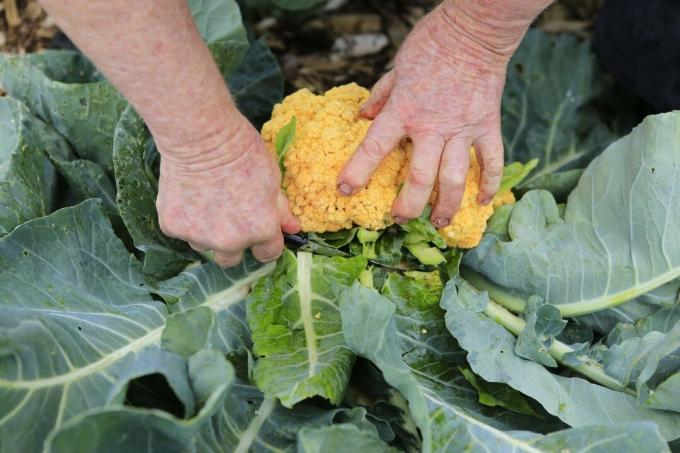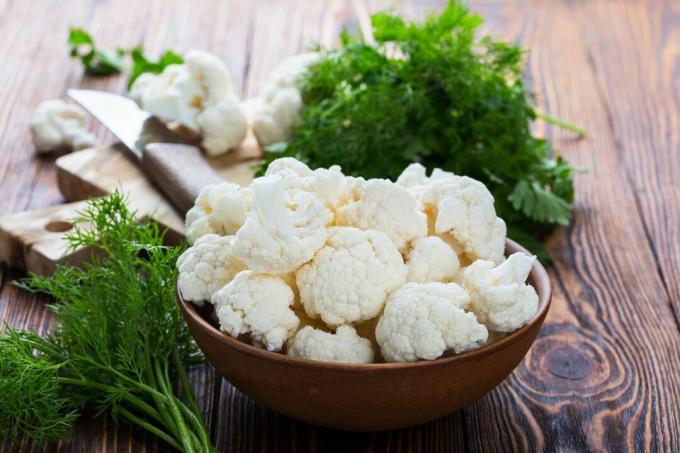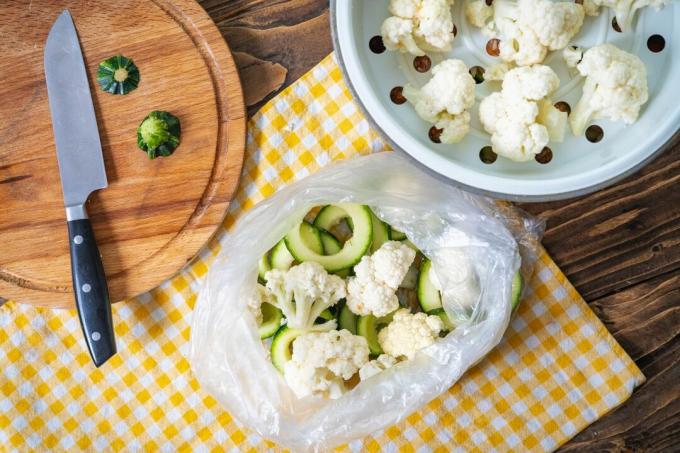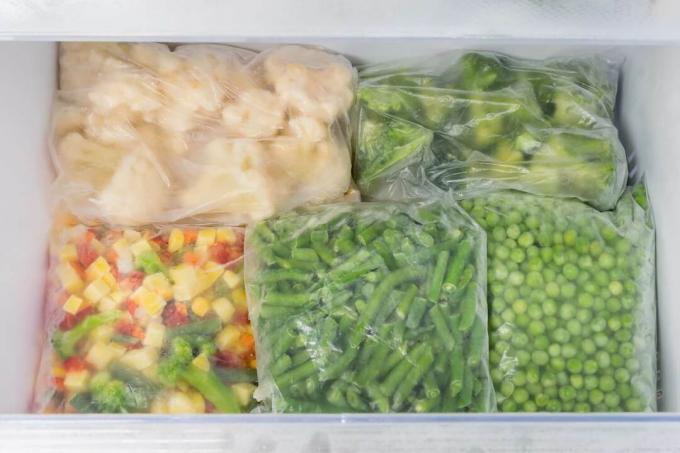After a rich cauliflower harvest, the cabbage must be stored properly. We show how to freeze cauliflower and how to preserve it.

After weeks of waiting and tending, the time has finally come between June and October, depending on the growing season: the first cauliflower heads can be harvested. The right harvest time is crucial here. cauliflower (Brassica oleracea var. botrytis) ripens unevenly, which is not exactly a disadvantage: A single set can be harvested for one to six weeks, depending on the variety and weather. Nevertheless, it can happen that too much of the delicious cabbage ripens at once and has to be preserved. We will tell you how to harvest cauliflower, how to store it for as long as possible and how to preserve it.
contents
-
harvest cauliflower
- Harvest time for cauliflower
- Cut the cauliflower properly
-
Storing and storing cauliflower
- How long does cauliflower last?
- Store cauliflower in the refrigerator
- Clean and wash the cauliflower
-
preserve cauliflower
- Freeze cauliflower
- Blanch and boil down the cauliflower
- insertion
-
Prepare cauliflower
- Can you eat cauliflower raw?
- Is green cauliflower edible?
- How healthy is cauliflower?
harvest cauliflower
Cauliflower rewards in summer and autumn with a rich harvest that needs to be brought in quickly. Before you can cook the cauliflower, it must first be harvested. We give tips so that you can recognize the best time to harvest and harvest the flower easily.

Harvest time for cauliflower
When your cauliflower is ready for harvest depends not only on the time of planting and the variety. The weather also has a huge impact on when the white florets are ready for harvest. Cauliflower in particular can be severely affected by temperatures that are too cool or too warm when young, so that the harvest occurs early or late. The practical thing about this is that many cauliflower plants planted at the same time usually reach harvest within a window of one to six weeks. The cauliflower harvest time can thus be stretched out a bit and you don't have to harvest everything at once. Harvest the white "flowers" before they look fluffy - the technical term is "gritty" - or discolour. They should be tight and closed.
tip: Cauliflower cannot actually be harvested too early. But if you harvest it too late, the quality and taste suffer. If you cut off the heads before they reach their final size, you still get the typical cauliflower flavor. Depending on the variety, the plant branches out and forms additional, small heads.
early Cauliflower Varieties can be harvested as early as mid-June, late varieties with a relatively late planting date until October. So-called winter cauliflower is not harvested until next spring. So you see, there is no cauliflower season like this, but the main harvest time in Germany is around June to October. The average cultivation time for cauliflower is 45 to 60 days, from planting to harvest.

Tip: Harvest your cauliflower for fresh consumption as needed and preferably early in the morning. Covered by its own leaves or a light fleece, it stays on the stem for a few weeks longer.
Cut the cauliflower properly
You don't need a lot of equipment to harvest cauliflower. Always cut your cauliflower with a sharp knife to minimize damage to the cabbage head. It stays fresh longer and loses less moisture. The harvest cut should be made well below the base of the flowers. Immediately after harvesting in the early morning, the flower should be cooled down with 0 to 4 °C cold water. Be sure to keep the cabbage clean so you won't have to clean as much later.

Tip: If you don't use the cauliflower directly, you can leave the bracts on the cauliflower head. So it stays fresh longer.
Storing and storing cauliflower
If you want to enjoy the white cabbage flowers outside of the cauliflower season, you have to store them properly. Storing the sensitive cabbage is not easy. That's why we give you tips so that you can enjoy the cauliflower as long as possible after the cauliflower harvest.

How long does cauliflower last?
Cauliflower there, just like broccoli (Brassica oleracea var. italiana), quickly drains a lot of water after harvest and gets a wilted, rubbery consistency. It's important that you store cauliflower properly, as it will keep fresh for up to six weeks, depending on how it's stored. Cauliflower reacts very sensitively to the ripening gas ethylene, which some types of fruit and vegetables give off to a greater extent as they ripen. The gas stimulates the cauliflower's cells to become more active, causing it to wilt and spoil more quickly. Cauliflower should therefore never be stored next to tomatoes and fruit that will ripen later, such as apples.
Store cauliflower in the refrigerator
Cauliflower can be stored in the refrigerator for some time. If it is freshly harvested, with leaves still on and stored unwashed, it can be stored at 0 to 4 °C for up to 14 days. Cauliflowers that have been harvested young will keep for up to six weeks at a constant temperature of 0 °C, over 97% relative humidity, in the dark and isolated from other types of vegetables.
tip: Water loss can be significantly reduced by wrapping the cauliflower in foil or a damp cloth.

Clean and wash the cauliflower
Before you prepare and cook the cauliflower, you should clean it of impurities. Due to its sprawling florets, the cabbage offers a lot of contact surface for dirt and dust, which is why thorough cleaning is necessary. First remove the leaves and separate the individual florets from the main stem. Brown discolored and damaged florets are sorted out when cleaning the cauliflower. Then wash the cauliflower florets under running water and drain them in a colander before cooking the cauliflower.
tip: If you cook cauliflower, it can only be kept in the refrigerator for a short time afterwards. Therefore, it is worth cooking only the required amount of cauliflower and using it up by the next day.

preserve cauliflower
The tasty cauliflower inflorescences can be preserved for a long time. We explain which methods work best so that you can cook cauliflower at a later date. We also tell you a few ways to preserve cauliflower.
Freeze cauliflower
The first way to preserve is to freeze the cauliflower. The white vitamin miracle differs from some of its peers, such as the Kale (Brassica oleracea var. sabellica), because it can be frozen raw without blanching. Before you freeze cauliflower, cut the individual florets from the cauliflower head, wash them and let them drain in a colander. Then portion the washed cauliflower and put it in the freezer. If necessary, you can cook the cauliflower without defrosting it first.

Blanch and boil down the cauliflower
To make cauliflower more durable and easier to digest, it is often blanched. This is also the first step in boiling or pickling the buds. To blanch, place the cut cauliflower florets in boiling salted water for a few minutes until they are just al dente. You can preserve the white color of the cabbage by adding a good dash of citric acid to the water. The florets can now be drained and should be rinsed with cool water.
To boil five heads of cauliflower in jars, take two liters of boiling salted water and fill florets and brine into jars. Only screw the lids loosely on the jars, as air must be able to escape during the preserving process. The jars are now boiled down for at least 20 minutes at 100 °C. This can be done, for example, in a high, water-filled casserole dish in the oven or by placing the glasses in a large, water-filled saucepan. After preserving, screw the lids on tightly and turn the jars upside down and leave to cool.
insertion
Like almost any vegetable, cauliflower can also be preserved by fermenting it, i.e. pickling it. To do this, you should cut and wash the raw cauliflower. A two to four percent brine is then made by dissolving 20 to 40 grams of pure salt in a liter of water. The cauliflower florets are then stacked as tightly as possible in the jar, leaving only 3 to 4 cm of space under the rim. A fermentation weight is placed on top of the cauliflower and finally the brine is poured into it. The fermentation weight should be completely covered with brine. The jar is now tightly closed and left at room temperature for five to seven days – this is how the fermentation gets going. After another two to three weeks of gentle fermentation in the refrigerator or in a cool cellar, the Pickled cauliflower is ready to eat and will keep for a few months - especially if the rim of the glass is clean is held.

Prepare cauliflower
There are many recipes for cauliflower, so you can boil cauliflower, steam it, bread it and much more. It is also possible to prepare cauliflower in the oven. In contrast to cultivation, which we discuss in our special article plant cauliflower treat more carefully, cooking cauliflower is less demanding.
Tip: Did you know that cauliflower leaves are edible? The outer, older leaves are less suitable, but the younger ones can be used to prepare a creamy soup, for example.
Can you eat cauliflower raw?
Yes, you can eat cauliflower raw. It is also often used in salads or eaten with a dip.

Is green cauliflower edible?
Yes, it is, because green cauliflower is similar to green cauliflower asparagus (Asparagus officinalis). If the leaves cover the cauliflower flower and protect it from sunlight, it will remain white. However, as soon as enough sunlight hits the flower, it forms the green pigment chlorophyll, which leads to a greenish discoloration. Depending on the variety, a purple or orange discoloration is also possible. Did you know that, for example, the one that is usually offered in green? Romanesco is a variant of cauliflower?
How healthy is cauliflower?
Cauliflower is considered healthy and easily digestible, it is rich in vitamin C and minerals. It also contains important trace elements and colored varieties also contain a high proportion of beta-carotene or anthocyanins.
Before you can preserve cauliflower, you need to secure the harvest and protect it from pests. Particularly common in cauliflower are the so-called Cabbage White (Piridae) and its insatiable caterpillars are a cause of damage. We present the butterfly species and give tips on how to combat them.
